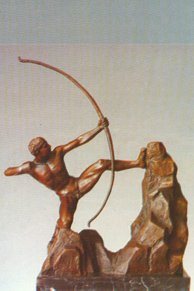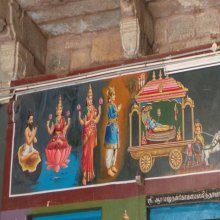Sharnga, Śārṅga: 19 definitions
Introduction:
Sharnga means something in Hinduism, Sanskrit, Jainism, Prakrit, biology. If you want to know the exact meaning, history, etymology or English translation of this term then check out the descriptions on this page. Add your comment or reference to a book if you want to contribute to this summary article.
The Sanskrit term Śārṅga can be transliterated into English as Sarnga or Sharnga, using the IAST transliteration scheme (?).
Images (photo gallery)
In Hinduism
Pancaratra (worship of Nārāyaṇa)
Source: Wisdom Library: PāñcarātraŚārṅga (शार्ङ्ग, “bow”):—One of the nine symbols representing the cosmic principles of the universe, according to the Pāñcarātra literature. These nine weapons and ornaments symbolize the principles which they represent as the presiding deity. The Bow (śārṅga) represents tāmasic ahaṃkāra (‘the mind’).

Pancaratra (पाञ्चरात्र, pāñcarātra) represents a tradition of Hinduism where Narayana is revered and worshipped. Closeley related to Vaishnavism, the Pancaratra literature includes various Agamas and tantras incorporating many Vaishnava philosophies.
Purana and Itihasa (epic history)
Source: archive.org: Puranic EncyclopediaŚārṅga (शार्ङ्ग).—Śrī Kṛṣṇa’s bow. The following facts about the bow are gathered from the Mahābhārata.
(i) When Kṛṣṇa exhibited his Viśvarūpa (cosmic form) in the assembly of the Kauravas he had held in one hand this bow. (Udyoga Parva, Chapter 131, Verse 10).
(ii) Kṛṣṇa’s Śārṅga is on a par with Indra’s bow called Vijaya. (Udyoga Parva, Chapter 158, Verse 4).
(iii) Śārṅga is one of the three divine bows. (Udyoga Parva, Chapter 158, Verse 5).
(iv) Śārṅga was made by Brahmā and presented to Kṛṣṇa. (Mahābhārata Southern text, Anuśāsana Parva, Chapter 141).
Source: archive.org: Shiva Purana - English TranslationŚārṅga (शार्ङ्ग) refers to a “bow”, according to the Śivapurāṇa 2.4.8 (“The battle between the gods and Asuras”).—Accordingly, as Brahmā narrated to Nārada: “[...] O sage, a great fight ensued between Viṣṇu and Tāraka. It was very fierce. It caused horripilation to the onlookers. Lifting up his club, Viṣṇu hit the Asura with great force but the powerful Asura split it with his trident. The infuriated lord offering shelter to the gods hit the leader of the Asuras by arrows discharged from his bow (śārṅga-cyuta). [...]”.
Source: Cologne Digital Sanskrit Dictionaries: The Purana IndexŚārṅga (शार्ङ्ग).—The bow of Hari, reached Kṛṣṇa during Jarāsandha's siege of Mathurā.*
- * Bhāgavata-purāṇa I. 6. 39; X. 50. 11 [13], 23; XII. 11. 15.

The Purana (पुराण, purāṇas) refers to Sanskrit literature preserving ancient India’s vast cultural history, including historical legends, religious ceremonies, various arts and sciences. The eighteen mahapuranas total over 400,000 shlokas (metrical couplets) and date to at least several centuries BCE.
Dhanurveda (science of warfare)
Source: Wisdom Library: DhanurvedaŚārṅga (शार्ङ्ग) refers to the bow of Viṣṇu. It is a Sanskrit word defined in the Dhanurveda-saṃhitā, which contains a list of no less than 117 weapons. The Dhanurveda-saṃhitā is said to have been composed by the sage Vasiṣṭha, who in turn transmitted it trough a tradition of sages, which can eventually be traced to Śiva and Brahmā.

Dhanurveda (धनुर्वेद) refers to the “knowledge of warfare” and, as an upaveda, is associated with the Ṛgveda. It contains instructions on warfare, archery and ancient Indian martial arts, dating back to the 2nd-3rd millennium BCE.
Ayurveda (science of life)
Nighantu (Synonyms and Characteristics of Drugs and technical terms)
Source: WorldCat: Rāj nighaṇṭuŚārṅga (शार्ङ्ग) is another name for Ārdraka, a medicinal plant identified with Zingiber officinale Rosc. or “ginger root” from the Zingiberaceae or “ginger” family of flowering plants, according to verse 6. 27-29 of the 13th-century Raj Nighantu or Rājanighaṇṭu.—Note: Śuṇṭhi is dried and specially prepared form of Ārdraka by removing the outer scales of the rhizome. The major part of the oil of ginger remains in these scales and is obtained from the Śuṇṭhī/Ārdraka with scales.—The sixth chapter (pippalyādi-varga) of this book enumerates ninety-five varieties of plants obtained from the market (paṇyauṣadhi). Together with the names Śārṅga and Ārdraka, there are a total of sixteen Sanskrit synonyms identified for this plant.
Toxicology (Study and Treatment of poison)
Source: Shodhganga: Kasyapa Samhita—Text on Visha ChikitsaŚārṅga (शार्ङ्ग) is the name of an ingredient used in the treatment (cikitsā) of bites of spiders (lūtā), according to the Kāśyapa Saṃhitā: an ancient Sanskrit text from the Pāñcarātra tradition dealing with both Tantra and Viṣacikitsā—an important topic from Āyurveda which deals with the study of Toxicology (Viṣavidyā or Sarpavidyā).—In the beginning of the twelfth Adhyāya, Kāśyapasaṃhita adds external and internal antidotes for poisons of various animals and insects. One of the treatments for scorpions (vṛścika) is mentioned as follows: “A lepa or paste made from Māñjiṣṭhā, sandalwood, Doṣā flowers, Śirīṣa and lily combined with Śārṅga and Oṣṭha , remove the damage caused by scorpions”.

Āyurveda (आयुर्वेद, ayurveda) is a branch of Indian science dealing with medicine, herbalism, taxology, anatomy, surgery, alchemy and related topics. Traditional practice of Āyurveda in ancient India dates back to at least the first millenium BC. Literature is commonly written in Sanskrit using various poetic metres.
General definition (in Hinduism)
Source: Wisdom Library: HinduismŚārṅga (शार्ङ्ग) is a Sanskrit word referring to the bow of Lord Kṛṣṇa.
In Jainism
General definition (in Jainism)
Source: archive.org: TrisastisalakapurusacaritraŚārṅga (शार्ङ्ग) refers to a divine bow and represents one of the nine gifts of the Gods given to Tripṛṣṭha, according to chapter 4.1 [śreyāṃsanātha-caritra] of Hemacandra’s 11th century Triṣaṣṭiśalākāpuruṣacaritra: an ancient Sanskrit epic poem narrating the history and legends of sixty-three illustrious persons in Jainism.
Accordingly:—“[...] The Vidyādharas, Jvalanajaṭin and others, mounted their chariots like lions a mountain-plateau. Then drawn by merit, the Gods gave Tripṛṣṭha a divine bow named Śārṅga, a club Kaumodakī, a conch Pāñcajanya, and a jewel named Kaustubha, a sword Nandaka, and a garland Vanamālā. They gave Balabhadra a plough named Saṃvartaka, a pestle named Saumanda, and a club named Candrikā. [...]”.

Jainism is an Indian religion of Dharma whose doctrine revolves around harmlessness (ahimsa) towards every living being. The two major branches (Digambara and Svetambara) of Jainism stimulate self-control (or, shramana, ‘self-reliance’) and spiritual development through a path of peace for the soul to progess to the ultimate goal.
Biology (plants and animals)
Source: Google Books: CRC World Dictionary (Regional names)Sharnga in India is the name of a plant defined with Zingiber officinale in various botanical sources. This page contains potential references in Ayurveda, modern medicine, and other folk traditions or local practices It has the synonym Amomum angustifolium Salisb., nom. illeg. (among others).
Example references for further research on medicinal uses or toxicity (see latin names for full list):
· Fl. Sichuanica (1992)
· The Gardeners Dictionary (1754)
· Cytologia (1985)
· Verhandelingen van het bataviaasch genootschap van kunsten en wetenschappen (1790)
· Cytologia (1997)
· Journal of Cytology and Genetics (1998)
If you are looking for specific details regarding Sharnga, for example chemical composition, pregnancy safety, extract dosage, diet and recipes, side effects, health benefits, have a look at these references.

This sections includes definitions from the five kingdoms of living things: Animals, Plants, Fungi, Protists and Monera. It will include both the official binomial nomenclature (scientific names usually in Latin) as well as regional spellings and variants.
Languages of India and abroad
Sanskrit dictionary
Source: DDSA: The practical Sanskrit-English dictionaryŚārṅga (शार्ङ्ग).—a.
1) Made of horn, horny.
2) Having a bow, armed with a bow; Bhaṭṭikāvya 8.123.
-rṅgaḥ, -rṅgam 1 A bow (in general); शार्ङ्गाकर्षावमुक्तप्रशिथिलकविका प्रग्रहेणात्र देशे (śārṅgākarṣāvamuktapraśithilakavikā pragraheṇātra deśe) Mu. 6.9; Bhaṭṭikāvya 8.123.
2) The bow of Viṣṇu; शार्ङ्गं पुनर्धनुर्दिव्यं विष्णोः परममायुधम् (śārṅgaṃ punardhanurdivyaṃ viṣṇoḥ paramamāyudham) Dhanur.44; शार्ङ्गं धनुर्मित्रमिव द्रढीयः (śārṅgaṃ dhanurmitramiva draḍhīyaḥ) Śi. 3.2.
-śārṅgaḥ [śṛṇāteḥ gaṇ śakunau Uṇādi-sūtra 1.118] A bird; also शार्ङ्गकः (śārṅgakaḥ); तस्मिन् वने दह्यमाने षडग्निर्न ददाह च । अश्वसेनं मयं चैव चतुरः शार्ङ्गकांस्तथा (tasmin vane dahyamāne ṣaḍagnirna dadāha ca | aśvasenaṃ mayaṃ caiva caturaḥ śārṅgakāṃstathā) || Mahābhārata (Bombay) 1.228.47.
-rṅgam Wet ginger.
Source: Cologne Digital Sanskrit Dictionaries: Shabda-Sagara Sanskrit-English DictionaryŚārṅga (शार्ङ्ग).—mfn.
(-rṅgaḥ-rṅgī-rṅgaṃ) 1. Horny, made of horn, &c. 2. Holding a bow. n.
(-rṅgaṃ) 1. A bow in general. 2. The bow of Vishnu. E. śṛṅga a horn, aṇ aff.
Source: Cologne Digital Sanskrit Dictionaries: Benfey Sanskrit-English DictionaryŚārṅga (शार्ङ्ग).—i. e. śṛṅga + a, I. adj. Horny, made of horn, etc. Ii. m. (n.?), 1. A bow, [Śākuntala, (ed. Böhtlingk.)] 94, 2. 2. The bow of Viṣṇu. 3. The name of a bird.
Source: Cologne Digital Sanskrit Dictionaries: Cappeller Sanskrit-English DictionaryŚārṅga (शार्ङ्ग).—[adjective] made of horn or coming from the Cṛṅga-tree. [masculine] a cert. bird ([feminine] ī); [neuter] bow ([especially] that of Viṣṇu).
Source: Cologne Digital Sanskrit Dictionaries: Monier-Williams Sanskrit-English Dictionary1) Śārṅga (शार्ङ्ग):—mf(ī)n. ([from] śṛṅga) made of horn, horny, corneous, [Suśruta]
2) derived or taken from the plant Śṛṅga (as poison), [Yājñavalkya]
3) armed with a bow, [Bhaṭṭi-kāvya]
4) m. a kind of bird, [Mahābhārata] (cf. śārga)
5) [patronymic] of various Vedic Ṛṣis, [Ṛgveda-anukramaṇikā]
6) n. a bow ([especially] that of Viṣṇu), [Mahābhārata; Harivaṃśa; Purāṇa]
7) fresh ginger, [cf. Lexicographers, esp. such as amarasiṃha, halāyudha, hemacandra, etc.]
8) Name of various Sāmans, [Ārṣeya-brāhmaṇa]
Source: Cologne Digital Sanskrit Dictionaries: Yates Sanskrit-English DictionaryŚārṅga (शार्ङ्ग):—[(rṅgaḥ-rṅgī-rṅgaṃ) m.] A bow; a horn. a. Made of horn.
Source: DDSA: Paia-sadda-mahannavo; a comprehensive Prakrit Hindi dictionary (S)Śārṅga (शार्ङ्ग) in the Sanskrit language is related to the Prakrit words: Saṃga, Sāraṃga.
[Sanskrit to German]
Sanskrit, also spelled संस्कृतम् (saṃskṛtam), is an ancient language of India commonly seen as the grandmother of the Indo-European language family (even English!). Closely allied with Prakrit and Pali, Sanskrit is more exhaustive in both grammar and terms and has the most extensive collection of literature in the world, greatly surpassing its sister-languages Greek and Latin.
Kannada-English dictionary
Source: Alar: Kannada-English corpusŚārṅga (ಶಾರ್ಙ್ಗ):—[adjective] of or made of the horn (of an animal); horny.
--- OR ---
Śārṅga (ಶಾರ್ಙ್ಗ):—[noun] a bow (a device used for shooting arrows) in gen. 2) name of the bow of Viṣṇu.
Kannada is a Dravidian language (as opposed to the Indo-European language family) mainly spoken in the southwestern region of India.
See also (Relevant definitions)
Starts with (+12): Sharngabhrit, Sharngacapa, Sharngacyuta, Sharngadatta, Sharngadeva, Sharngadhanurdhara, Sharngadhanus, Sharngadhanva, Sharngadhanvan, Sharngadhanvi, Sharngadhanvin, Sharngadhara, Sharngadhara mishra, Sharngadharapaddhati, Sharngadharasamhita, Sharngadharavrajya, Sharngadhari, Sharngadhariya, Sharngajagdha, Sharngajagdhi.
Full-text (+63): Sharngin, Saranga, Sharngadhanvan, Sharngapani, Sanga, Sharngabhrit, Sharngadhara, Sharngayudha, Sharngaka, Sarisrikta, Sharngacapa, Jaritar, Sharngadharapaddhati, Sharngadharasamhita, Sharngadhariya, Sharngapanistotra, Sharngadharavrajya, Sharngadhanurdhara, Sharngajagdha, Sharngadhanvin.
Relevant text
Search found 35 books and stories containing Sharnga, Śārṅga, Sarnga, Śarṅga; (plurals include: Sharngas, Śārṅgas, Sarngas, Śarṅgas). You can also click to the full overview containing English textual excerpts. Below are direct links for the most relevant articles:
Garga Samhita (English) (by Danavir Goswami)
Verse 6.1.21 < [Chapter 1 - Jarāsandha’s Defeat]
Verse 6.6.9 < [Chapter 6 - The Yādavas’ Victory When Śrī Rukmiṇī is Kidnapped]
Verse 6.1.17 < [Chapter 1 - Jarāsandha’s Defeat]
Mahabharata (English) (by Kisari Mohan Ganguli)
Jarasandha < [Fifth Section]
The Devi Bhagavata Purana (by Swami Vijñanananda)
Chapter 9 - On the fight between the Riṣis and Prahlāda < [Book 4]
Chapter 6 - On the Deva Dānava fight < [Book 5]
The Skanda Purana (by G. V. Tagare)
Chapter 28 - The Lord Adopts the Form of Nṛsiṃha < [Section 2 - Puruṣottama-kṣetra-māhātmya]
Chapter 85 - Greatness of Mahālakṣmī < [Section 1 - Tīrtha-māhātmya]
Chapter 12 - Churning of the Ocean: Birth of Fourteen Precious Jewels < [Section 9 - Vāsudeva-māhātmya]
Chaitanya Bhagavata (by Bhumipati Dāsa)
Verse 1.12.157 < [Chapter 12 - The Lord’s Wandering Throughout Navadvīpa]
Verse 3.9.232-233 < [Chapter 9 - The Glories of Advaita]
Related products


